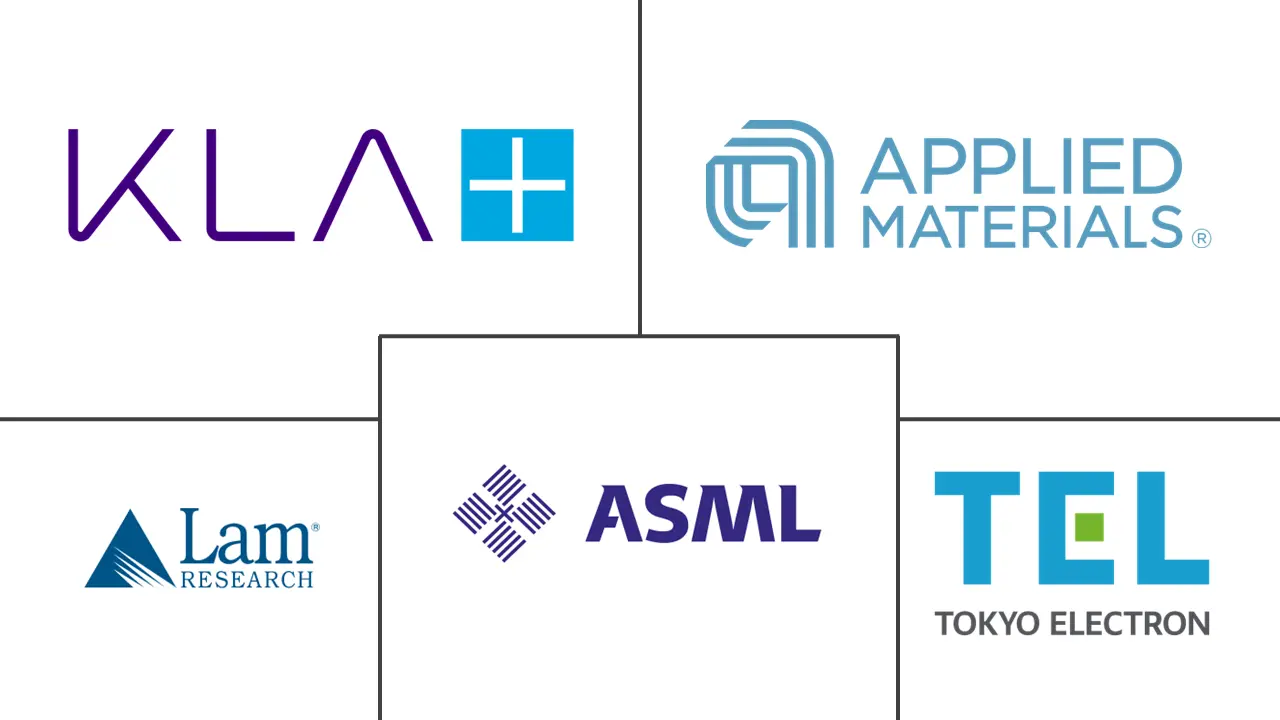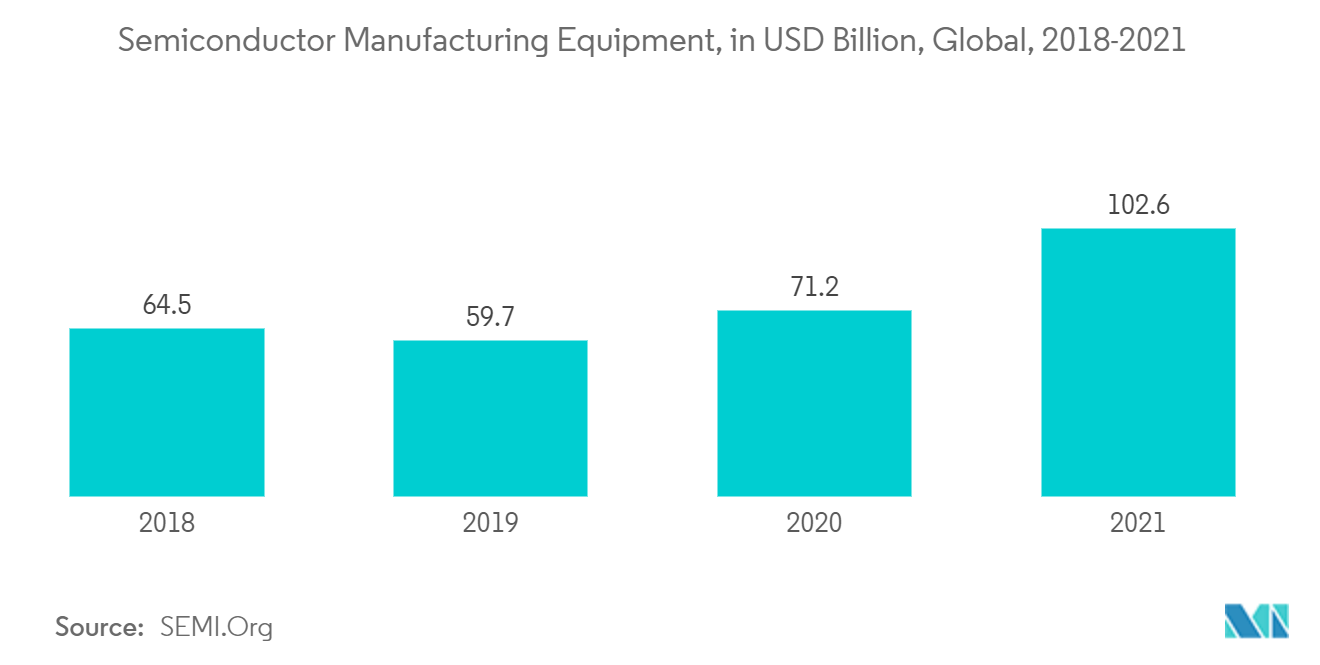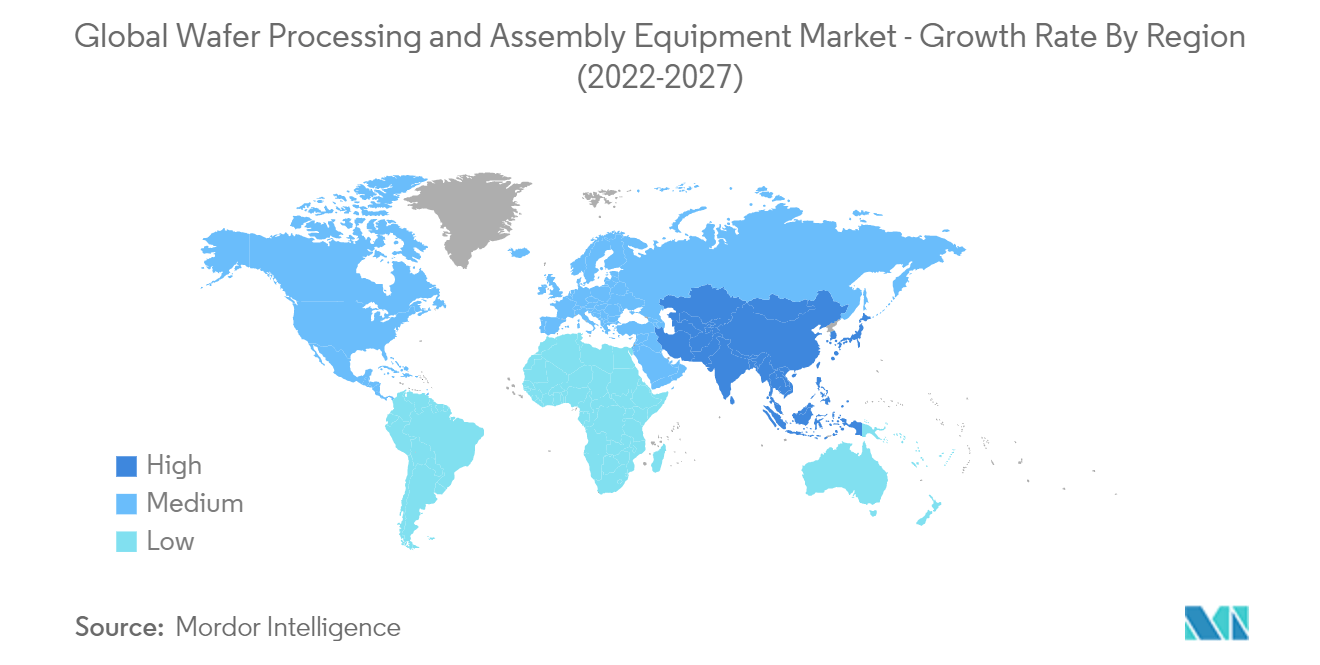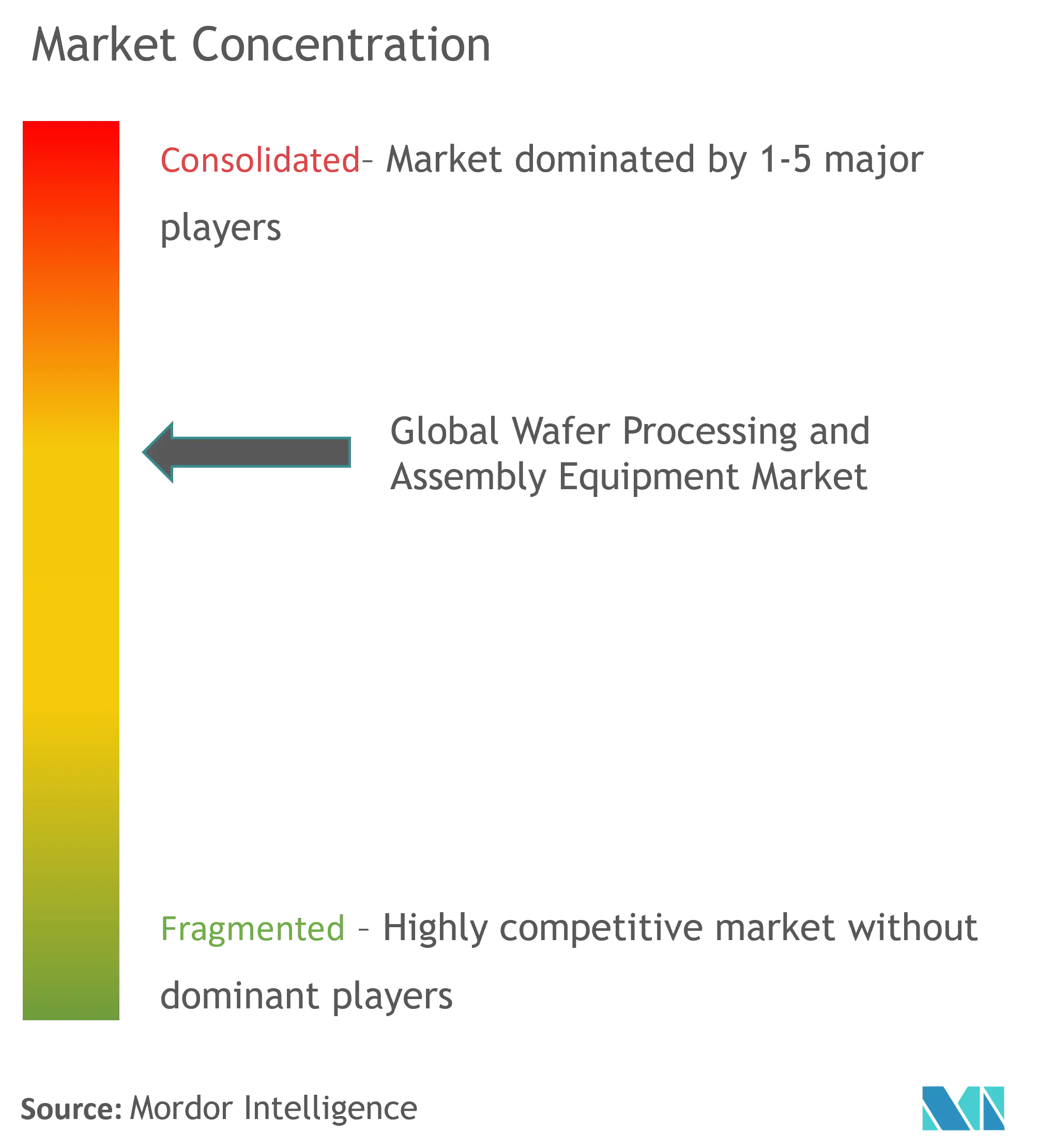Wafer Processing & Assembly Equipment Market Size

| Study Period | 2019 - 2029 |
| Base Year For Estimation | 2023 |
| CAGR | 8.40 % |
| Fastest Growing Market | Asia-Pacific |
| Largest Market | Asia-Pacific |
| Market Concentration | Medium |
Major Players
*Disclaimer: Major Players sorted in no particular order |
Wafer Processing & Assembly Equipment Market Analysis
The Global Wafer Processing and Assembly Equipment Market is expected to grow at a CAGR of 8.4% during the forecast period of 2022 to 2027. The wafer processing and assembly equipment market is expected to grow in response to rising consumer electronics demand. Customer expectations for improved qualities of new electronic gadgets have risen as demand for electronic products has increased. Several consumer electronics and identity solutions, such as identification tags, smart cards, and others, combine RFIDs with wafers for integrated circuit fabrication. Customers increasingly demand ultra-smooth surfaces and smaller wafers for seamless integration into electronic products.
- According to the Indian Brand Equity Foundation, In 2022, the Indian appliance and consumer electronics (ACE) sector is predicted to grow at a 9% compound annual growth rate (CAGR) to INR 3.15 trillion (USD 48.37 billion). The Indian electronics manufacturing sector is expected to reach USD 300 billion (INR 22.5 lakh crore) by 2024-25. Furthermore, increased consumer electronics device usage and consumption are predicted to fuel semiconductor demand, boosting wafer processing and assembly equipment market revenues throughout the projection period.
- A prominent trend in the wafer processing and assembly equipment industry is the growing demand for miniaturized wafers with higher device performance. Wafers, for example, are flattened down to final thicknesses of tens of micrometers. Most semiconductor wafers used in memory, CIS, and power applications are reduced to 100 µm-200 µm in thickness. In the case of memory devices, further thickness reduction is required due to the need to maximize the memory capacity of single packages, increased data transmission rates, and power consumption fueled mostly by mobile applications. Silicon wafers thicker than 200 µm are used in standard memory devices like 2D NAND/DRAM.
- The government bodies in the different regions are planning to invest in the production of semiconductors, which may create an opportunity for the studied market to grow. For instance, in September 2021, Germany's economy ministry stated that the country is willing to invest EUR 3 billion in the EU's "Important Projects of Common European Interest" initiative, which is one of the EU's primary subsidy tools for stimulating investment and reducing import dependency. The money will be used by the German government to build new semiconductor manufacturing factories. This investment is primarily aimed at reducing dependency on imported semiconductors for future semiconductor needs. Government policies like this will significantly drive the studied market.
- Wafers are subjected to mechanical loads induced by sawing, manual handling, liquid jets, transport systems, and pick and place equipment during the wafer manufacturing cycle. Power semiconductors on the market now are generally made on 200-mm wafers with thicknesses ranging from 50 to 100 µm, although their roadmaps allow for wafers as thin as 1 µm. Mechanical polishing thins the backside of these wafers. Grinding marks, grinding failures resulting in edge chips, star cracks, and comets generated by edge particles caught in the grinding wheel, embedded particles, cleavage lines, and a variety of other faults are all defects caused by the polishing process.
- Furthermore, the global shortage of wafer semiconductors led by the COVID-19 pandemic has encouraged players to focus on increasing production capacity. For instance, Semiconductor Manufacturing International Corp (SMIC) has indulged in aggressive plans to double its production capacity by 2025 by constructing new chip fabrication plants in different cities, including its announcement in September 2021 to establish a new factory in Shanghai's free trade zone.
Wafer Processing & Assembly Equipment Market Trends
This section covers the major market trends shaping the Wafer Processing & Assembly Equipment Market according to our research experts:
Thin Film Deposition is One of the Factor Driving the Market
- The Chemical Vapor Deposition (CVD) technology is commonly employed in the fabrication of semiconductors and thin films. The expansion of the CVD equipment market is primarily driven by increasing demand for microelectronics-based consumer items, which is resulting in quicker growth of the semiconductor, LED, and storage device industries, as well as severe limits on the use of Cr6 for electroplating.
- In January 2022, ThermVac Inc., a Korean manufacturer of special vacuum furnaces, continues to respond to the needs of domestic and international clients by developing process technology and design and manufacturing technology for CVD equipment that can be used at temperatures ranging from 900°C to 2,400°C. This corresponds to the growing demand for high-temperature heat-resistant CVD components in high-tech industries like semiconductors, solar power, mobile phones, aerospace, and defense.
- The linear sputtering equipment is used in applications like solar energy, display, Data storage, semiconductor, and many more. For instance, in December 2021, Bosch started the volume production of Sic-based power semiconductors supplying automotive manufacturers worldwide. To meet the increasing demand for such semiconductors, an extra 10,764 square feet were already added to the clean-room space at the Bosch wafer fab in Reutlingen in 2021. Another 32,292 square feet will be added by the end of 2023. Such an increase in the production of semiconductors will drive the studied market.
- The advancements in the regional automotive industry are expected to create significant opportunities for market growth. For instance, Dubai recently launched a campaign to have 42,000 EVs on the streets of Emirates by 2030. The sputtering equipment is used in the coating of Drive train bearings and components as the increase in the developments of EV vehicles will significantly drive the studied market.
- Sputtered thin films are increasingly being used in biomedical applications. An example is a cylindrical magnetron sputtering to deposit protective coatings on batches of medical stents. Nano-films are widely employed in electronics, textiles, pharmaceuticals, ceramics, and various other applications. Fabrics coated with Nanofilm are often created by chemical vapor deposition, sol-gel technique, and magnetron sputtering. The magnetron sputtering method, for example, offers the benefits of controlled film thickness, high purity, high speed and low temperature, excellent adhesion, ease of operation, and environmental friendliness, among others.

Asia Pacific Holds the Major Share of the Market
- Asia-Pacific has the world's fastest-growing semiconductor market. Many vendors are setting up production facilities in the region in response to strong demand for smartphones and other consumer electronics gadgets from nations including China, the Republic of Korea, and Singapore.
- The companies are expanding their presence in the region by starting new projects to cater to the wide need of the customer. For instance, in September 2021, UTAC Holding, Ltd. added state-of-the-art plasma dicing and multi-project wafer (MPW) capabilities to a range of advanced semiconductor manufacturing solutions. Plasma dicing narrows the scribe line width between chips and increases the number of chips per wafer. Also, it provides "nearly perfect" cutting quality with no chips or cracks, which is a clear advantage over traditional mechanical sawing processes that lead to chronic sidewall quality issues.
- Further public agencies and private companies are investing in new products and research & development facilities. For instance, In September 2021, China's largest contract chipmaker Semiconductor Manufacturing International Corp (SMIC) announced the company's agreement with the Lin-Gang Special area-part of Shanghai's free trade zone. This agreement enables SMIC to establish a new foundry with a monthly planned capacity of 100,000 12-inch wafers. Also, in March 2021, the company announced an investment of USD 2.35 billion in coordination with the Shenzhen government for a manufacturing facility to produce 28nanometre (nm) and above integrated circuits with a monthly capacity of 40,000 12-inch wafers.
- Similarly, in October 2021, the Government of New South Wales is aware that the global semiconductor industry lacks Australia's major players and plans a new center to improve the feasibility of critical jobs in this sector. The hub, the Semiconductor Sector Service Bureau (S3B), will be based in Sydney's Tech Central and be funded by the state government. Further, Chief Scientist and Engineer Office, after researching the national semiconductor scene, mentioned there are currently no major Australian companies with semiconductor design or semiconductor development as their core business. The new hub leverages the country's wafer processing and dicing equipment market.
- The demand for stealth dicing equipment is growing as TSV (Through Silicon Via) technology becomes more prevalent for low-power, high-performance devices such as mobile phones and other wireless and networking devices. As TSV can package 2.5/3D for the applications listed above, the equipment is useful for TSV Assembly/Packaging (chip-to-chip and chip-to-wafer assembly with stealth dicing and other processes). In Memory and Logic, a combination of laser dicing and blade dicing is used.

Wafer Processing & Assembly Equipment Industry Overview
The Global Wafer Processing and Assembly Equipment market is moderately consolidated. Players tend to invest in innovating their product offerings to cater to the different industry's changing demands. Moreover, players adopt strategic activities like partnerships, mergers, and acquisitions to expand their presence. Some of the recent developments in the market are:
- March 2022 - SK siltron announced the beginning of the operation of the Silicon carbide (SiC) semiconductor wafer manufacturing plant in Bay City, Michigan, US. The company has a plan to produce around 60,000 annually. Also, a 6-inch SiC wafer is the main product of the company.
- September 2021 - Infineon Technologies AG launched its high-tech chip factory for power semiconductor devices on 300-millimeter thin wafers at its Villach site in Austria. At EUR 1.6 billion, the investment made by the company represents one of the largest such projects in the microelectronics sector in Europe. According to the company, the annual capacity planned for industrial semiconductors from the facility is sufficient to equip solar systems producing a total of around 1,500 TWh of electricity, which is around three times the annual power consumption of Germany.
Wafer Processing & Assembly Equipment Market Leaders
-
Applied Materials Inc.
-
ASML Holding Semiconductor Company
-
Tokyo Electron Limited
-
Lam Research Corporation
-
KLA Corporation
*Disclaimer: Major Players sorted in no particular order

Wafer Processing & Assembly Equipment Market News
- February 2022 - UK university research spin-out Intrinsic Semiconductor Technology's ReRAM that can be manufactured on the same CMOS wafers as microcontrollers, allowing for integrated SRAM-speed non-volatile memory without using separate NAND chips.
- November 2021 - Texas Instruments Incorporated (TI) announced new 300-millimeter semiconductor wafer fabrication plants in Sherman, Texas. Because semiconductor development in electronics, particularly in the industrial and automotive applications, is likely to continue long into the future, the company's North Texas location has the potential for up to four fabs to meet demand over time. The first and second fabs are expected to be completed in 2022.
Wafer Processing & Assembly Equipment Market Report - Table of Contents
1. INTRODUCTION
- 1.1 Study Assumption And Market Defination
- 1.2 Scope of the study
2. RESEARCH METHODOLOGY
3. EXECUTIVE SUMMARY
4. MARKET INSIGHTS
- 4.1 Market Overview
-
4.2 Industry Attractiveness - Porter's Five Forces Analysis
- 4.2.1 Bargaining Power Of Suppliers
- 4.2.2 Bargaining Power Of Buyers
- 4.2.3 Threat Of New Entrants
- 4.2.4 Threat Of Substitutes
- 4.2.5 Intensity Of Competitive Rivalry
- 4.3 Assessment of the Impact of Covid-19 on the Market
5. MARKET DYNAMICS
-
5.1 Market Drivers
- 5.1.1 Increasing Needs of Consumer Electronic Devices Boosting the Manufacturing Prospects
- 5.1.2 Proliferation of Artificial Intelligence, IoT and Connected Devices across Industry Verticals
-
5.2 Market Challenges
- 5.2.1 Dynamic Nature of Technologies Requires Several Changes in Manufacturing Equipment
6. MARKET SEGMENTATION
-
6.1 By Equipment Type
- 6.1.1 Chemical Mechanical Polishing (CMP)
- 6.1.2 Etching
- 6.1.3 Thin Film Deposition
- 6.1.3.1 CVD
- 6.1.3.2 Sputter
- 6.1.3.3 Other Type
- 6.1.4 Photoresist Processing
- 6.1.5 Assembly Equipment
- 6.1.5.1 Die Attach
- 6.1.5.2 Wire Bonding
- 6.1.5.3 Packaging
- 6.1.5.4 Inspection, Dicing, Plating and Others
-
6.2 By Geography
- 6.2.1 Asia-Pacific
- 6.2.2 North America
- 6.2.3 Rest of the World
-
6.3 By Product - Wafer Processing Equipment
- 6.3.1 DRAM
- 6.3.2 NAND
- 6.3.3 Foundry/Logic
- 6.3.4 Other Products
7. VENDOR RANKING ANALYSIS
8. COMPETITIVE LANDSCAPE
-
8.1 Company Profiles
- 8.1.1 Applied Materials Inc
- 8.1.2 ASML Holding Semiconductor Company
- 8.1.3 Tokyo Electron Limited
- 8.1.4 Lam Research Corporation
- 8.1.5 KLA Corporation
- 8.1.6 Hitachi High-Technologies Corporation
- 8.1.7 Disco Corporation
- 8.1.8 ASM Pacific Technology
- 8.1.9 Kulicke and Soffa Industries, Inc
- 8.1.10 BE Semiconductor Industries N.V
- 8.1.11 Towa Corporation
- *List Not Exhaustive
9. INVESTMENT ANALYSIS
10. FUTURE OF THE MARKET
** Subject To AvailablityWafer Processing & Assembly Equipment Industry Segmentation
Wafer processing equipment creates minute, multi-layer circuits on round silicon wafers primarily through physical and chemical methods. While various types of equipment are utilized to carry out these microscopic activities, most of these items can be divided into several groups. The Global Wafer Processing and Assembly Equipment Market is segmented by Equipment Type (Chemical Mechanical Polishing (CMP), Etching, Thin Film Deposition(CVD, Sputter), Photoresist Processing, Assembly Equipment (Die Attach, Wire Bonding, Packaging, Inspection, Dicing, Plating and Other), by Product (DRAM, NAND, Foundry/Logic) and Geography.
| By Equipment Type | Chemical Mechanical Polishing (CMP) | |
| Etching | ||
| Thin Film Deposition | CVD | |
| Sputter | ||
| Other Type | ||
| Photoresist Processing | ||
| Assembly Equipment | Die Attach | |
| Wire Bonding | ||
| Packaging | ||
| Inspection, Dicing, Plating and Others | ||
| By Geography | Asia-Pacific | |
| North America | ||
| Rest of the World | ||
| By Product - Wafer Processing Equipment | DRAM | |
| NAND | ||
| Foundry/Logic | ||
| Other Products |
Wafer Processing & Assembly Equipment Market Research FAQs
What is the current Global Wafer Processing and Assembly Equipment Market size?
The Global Wafer Processing and Assembly Equipment Market is projected to register a CAGR of 8.40% during the forecast period (2024-2029)
Who are the key players in Global Wafer Processing and Assembly Equipment Market?
Applied Materials Inc., ASML Holding Semiconductor Company, Tokyo Electron Limited, Lam Research Corporation and KLA Corporation are the major companies operating in the Global Wafer Processing and Assembly Equipment Market.
Which is the fastest growing region in Global Wafer Processing and Assembly Equipment Market?
Asia-Pacific is estimated to grow at the highest CAGR over the forecast period (2024-2029).
Which region has the biggest share in Global Wafer Processing and Assembly Equipment Market?
In 2024, the Asia-Pacific accounts for the largest market share in Global Wafer Processing and Assembly Equipment Market.
What years does this Global Wafer Processing and Assembly Equipment Market cover?
The report covers the Global Wafer Processing and Assembly Equipment Market historical market size for years: 2019, 2020, 2021, 2022 and 2023. The report also forecasts the Global Wafer Processing and Assembly Equipment Market size for years: 2024, 2025, 2026, 2027, 2028 and 2029.
Global Wafer Processing and Assembly Equipment Industry Report
Statistics for the 2024 Global Wafer Processing and Assembly Equipment market share, size and revenue growth rate, created by Mordor Intelligence™ Industry Reports. Global Wafer Processing and Assembly Equipment analysis includes a market forecast outlook to 2029 and historical overview. Get a sample of this industry analysis as a free report PDF download.



